
Pseudotsuga is a genus of evergreen coniferous trees in the family Pinaceae.

Quercus kelloggii, the California black oak, also known as Kellogg oak, is an oak in the red oak section, native to western North America. Although genetically separated from them for more than 20 million years its leaves are remarkably similar in appearance to several other members of the red oak section including the red oak and the black oak found in eastern and central North America.

Temperate rainforests are coniferous or broadleaf forests that occur in the temperate zone and receive heavy rain.
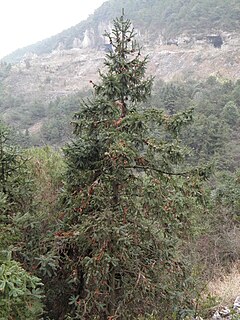
Cunninghamia is a genus of one or two living species of evergreen coniferous trees in the cypress family Cupressaceae. They are native to China, northern Vietnam and Laos, and perhaps also Cambodia. They may reach 50 m (160 ft) in height. In vernacular use, it is most often known as Cunninghamia, but is also sometimes called "China-fir". The genus name Cunninghamia honours Dr. James Cunningham, a British doctor who introduced this species into cultivation in 1702 and botanist Allan Cunningham.

The marsh shrew, also known as the Pacific water shrew, Bendire's water shrew, Bendire's shrew and Jesus shrew is the largest North American member of the genus Sorex. Primarily covered in dark-brown fur, it is found near aquatic habitats along the Pacific coast from southern British Columbia to northern California. With air trapped in its fur for buoyancy, marsh shrews can run for three to five seconds on top of the water. It measures about 16 cm (6.3 in) in length, including a 7-centimetre (2.8 in)-long tail, and weighs an average of 14.5–16 g (0.51–0.56 oz). The marsh shrew's diet consists mainly of invertebrates, which it hunts on land and in the water. They are rare; their populations are thought to be in decline, and they are considered endangered in parts of their range.
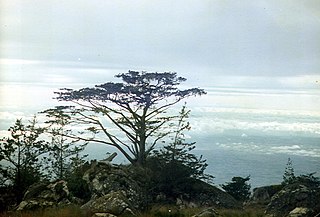
Widdringtonia is a genus of coniferous trees in the Cupressaceae. The name was Austrian botanist Stephan Endlicher's way of honouring an early expert on the coniferous forests of Spain, Capt. Samuel Edward Widdrington (1787–1856). There are four species, all native to southern Africa, where they are known as cedars or African cypresses.

The pinyon mouse is native to the southwestern United States and Baja California in Mexico. These medium-sized mice are often distinguished by their relatively large ears. The range of this species extends from southern Oregon and Wyoming in the north, and extends south to roughly the U.S.-Mexico border, with a disjunct population designated as Peromyscus true comanche that occupies an area in the vicinity of Palo Duro Canyon in the Texas panhandle.

Daeodon is an extinct genus of entelodont artiodactyl that inhabited North America about 23 to 20 million years ago during the latest Oligocene and earliest Miocene. The type species is Daeodon shoshonensis, described by a very questionable holotype by Cope. Some authors synonimize it with Dinohyus hollandi and several other species, but due to the lack of diagnostic material, this is questionable at best.
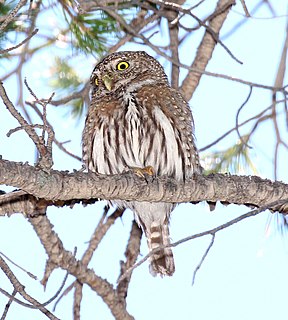
The northern pygmy owl is a small owl native to western North America.

The montane shrew is a species of mammal in the family Soricidae commonly known as the dusky shrew. Monticolus is derived from the Latin root word mons meaning mountain. It is found in Alaska, western Canada, the western United States in Washington, Idaho, Montana, Utah, Colorado, New Mexico, Arizona, Oregon, Nevada, and California, as well as in Mexico.

The Cranaidae are a family of neotropical harvestmen within the suborder Laniatores.

There are at least 9 large terrestrial mammal, 50 small mammal and 14 marine mammal species known to occur in Olympic National Park.
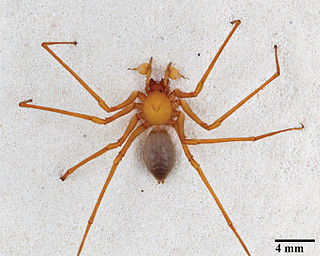
Trogloraptor is a genus of large spiders found in the caves of southwestern Oregon. It is the sole genus in the family Trogloraptoridae, and includes only one species, Trogloraptor marchingtoni. These spiders are predominantly yellow-brown in color with a maximum leg span of 3 in (7.6 cm). They are remarkable for having hook-like claws on the raptorial last segments of their legs.
Fischerula is a genus of two truffle-like fungi in the family Morchellaceae. First described from central Italy by Oreste Mattirolo in 1928, the genus name honors Swiss mycologist Eduard Fischer. The type species Fischerula macrospora is known only from Italy, while Fischerula subcaulis is found in coniferous and mixed forests of Oregon and Washington.
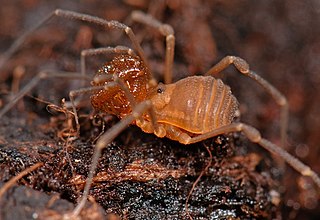
Cryptomaster leviathan is an opilionid arachnid known from southeastern Oregon. It is named after the Leviathan of the Book of Job in the Hebrew Bible due to its large body size compared to most travunioid Laniatores.

Cryptomaster is a genus of armoured harvestmen in the family Cryptomastridae. There are two described species in Cryptomaster, both found in Oregon.

Cryptomastridae is a family of armoured harvestmen in the order Opiliones. There are two genera and four described species in Cryptomastridae, found in Oregon and Idaho.

Briggsus is a genus of armoured harvestmen in the family Cladonychiidae. There are about five described species in Briggsus, found in the coastal forests of Oregon and Washington.















